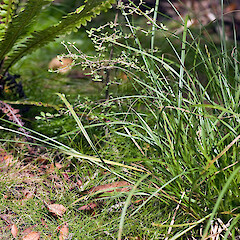Carex leporina
Common name
oval sedge
Synonyms
Carex ovalis Gooden.
Family
Cyperaceae
Flora category
Vascular – Exotic
Structural class
Sedges
NVS code
The National Vegetation Survey (NVS) Databank is a physical archive and electronic databank containing records of over 94,000 vegetation survey plots - including data from over 19,000 permanent plots. NVS maintains a standard set of species code abbreviations that correspond to standard scientific plant names from the Ngä Tipu o Aotearoa - New Zealand Plants database.
CARLEP
Conservation status
Not applicable
Brief description
Dense pale green grass-like tufts or mat-like swards up to 1 m tall, with slightly taller flower stem bearing brown oval heads near the tip.
Distribution
Locally common throughout New Zealand.
Habitat
Wide variety of wet habitats from lowland to subalpine, especially disturbed habitats, but also a problem weed in short turf wetland where it can completely displace indigenous vegetation.
Wetland plant indicator status rating
Information derived from the revised national wetland plant list prepared to assist councils in delineating and monitoring wetlands (Clarkson et al., 2021 Manaaki Whenua – Landcare Research Contract Report LC3975 for Hawke’s Bay Regional Council). The national plant list categorises plants by the extent to which they are found in wetlands and not ‘drylands’. The indicator status ratings are OBL (obligate wetland), FACW (facultative wetland), FAC (facultative), FACU (facultative upland), and UPL (obligate upland). If you have suggestions for the Wetland Indicator Status Rating, please contact: [Enable JavaScript to view protected content]
FACW: Facultative Wetland
Usually is a hydrophyte but occasionally found in uplands (non-wetlands).
Detailed description
Dense tufts; rhizome short. Stems 20–60–(120) cm tall, 3-angled, scabrid just below inflorescence. Leaves 1.5–3.5 mm wide, usually < stems, ± flat, ± soft, bright green, sheaths light brown. Inflorescence a compact ovoid head 2.5–4–(6) cm long, of 3–5–(11) approximate, sessile, light green to light brown spikes; bracts glume-like and inconspicuous or > inflorescence and ± setaceous. Spikes androgynous, male flowers at base. Glumes = or slightly < utricles, light brown with paler green to brown midrib, acute. Utricles 4–4.5 × ± 2 mm, ovoid, plano-convex, distinctly nerved, with winged margins almost covered by glumes, scabrid towards the tapered beak of ± 1 mm long. Stigmas 2. Nut plano-convex, ± oblong.
Similar taxa
Two other Carex spp. have oval spikes (C. scoparia and C. longii). Both these species have glumes shorter than the utricle, so C. leporina spikes appear less compact (see comparison with C. scoparia in photo).
Flowering
Late spring to early summer
Flower colours
Brown, Green
Fruiting
Summer to autumn
Life cycle
Seed dispersed by contaminated machinery or waterfowl.
Year naturalised
1879
Origin
Europe, Asia, North Africa
Reason for introduction
Unknown, seed or soil contaminant.
Control techniques
Can be controlled manually, mechanically or herbicidally depending on situation.
Etymology
carex: Latin name for a species of sedge, now applied to the whole group.
Attribution
Prepared by Paul Champion and Deborah Hofstra (NIWA). Features description from Healy and Edgar (1980).
References and further reading
Champion P. et al. 2020. Freshwater Invasive Species of New Zealand 2020. NIWA publication. https://docs.niwa.co.nz/library/public/FreInSpec.pdf
Healy AJ, Edgar E. 1980. Flora of New Zealand, Volume III. Adventive Cyperaceous, Petalous and Spathaceous Monocotyledons. Government Printer, Wellington, NZ. 220 p.
Johnson PN, Brooke PA. 1989. Wetland plants in New Zealand. DSIR Field Guide, DSIR Publishing, Wellington, NZ. 319 p.








